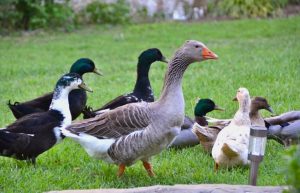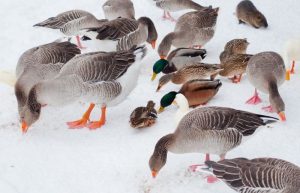
How Are Ducks and Geese Different?
You’re probably familiar with both ducks and geese. Geese make honking sounds, and ducks have an infamous “quack.” They both hang out around local lakes and rivers, too. Geese and ducks are relatively easy to distinguish from each other physically speaking. Still, both are classified as waterfowl, so where do the differences between these two lie?
What are the differences between ducks and geese? Geese and ducks differ in physical ways, such as the color of their feathers and their build. They can also vary in behavioral ways, like their mating patterns, diets, and vocalizations. Though ducks and geese share similar qualities, such as migration routes, ducks and geese are two very different types of birds.
If you plan on raising ducks and geese in a co-existing flock, understanding the differences between the two animals can help you provide better care. To learn more about the difference between ducks and geese, keep reading!
Physical Differences Between Ducks and Geese
So now that you understand the similarities between ducks and geese, let’s discuss the main physical differences. You may know, based on your mental image of the birds, that they look different. But how, exactly, are these birds anatomically distinct?
Color Differences Between Ducks and Geese
One of the easiest-to-spot distinctions between geese and ducks is the color of their feathers. Male ducks and female ducks have different coloring simply within their species of bird. Still, male and female geese can look entirely alike.
Male ducks have brightly colored heads that are often green or dark blue. Their heads are beautifully jewel-toned to distract predators from their duly-colored female mates. Male ducks, or drakes, have brightly-colored heads for reproductive purposes as well. Females are attracted to the vivid hues, which help the ducks reproduce and make more cute baby ducks.
Geese, on the other hand, are not as flashy in color as ducks are. Both the male and female geese look almost identical, with no distinct physical differences from afar. A typical goose only comes in one of three primary colors: grey, white, or black. The exception to these hues, of course, is their feet. Goose feet can come in a variety of colors, such as pink, orange, and brown.
Build and Body Differences Between Ducks and Geese
Another physical way that ducks and geese vary is in their builds and bodies. Let’s go over the key, visible differences between ducks and geese.
First of all, ducks have a smaller stature than geese. They typically weigh between one and four pounds per bird, depending on the individual species. Geese weigh much more, coming in at anywhere between four and eight pounds per bird. Ultimately, this means you’d much prefer a duck chasing you through a pond than a goose.
Geese also have longer appendages than ducks do. Their necks are longer than ducks’ necks due to a higher number of bones in their body. Their legs are also longer, which can provide them with faster, on-land traveling times than ducks. These longer limbs, combined with their heftier size, make geese more intimidating than ducks! (To learn more, read my article Do Ducks Bite? Everything You Need to Know.)
The last physical difference that I want to touch on is each birds’ respective bill. For context, the bill of a bird is equivalent to a nose or snout. It’s how they breathe, eat, and vocalize. Ducks have flatter bills than geese do, which places their nose holes higher up on their face. Geese bills are the exception to the “geese have longer, bigger body parts than ducks” rule as their bills are shorter than duckbills.
The difference in bill shapes and sizes can most likely be attributed to each birds’ diet, as geese rely more heavily on vegetation. At the same time, ducks eat a variety of plants and small insects, and animals.
Lifespan Differences Between Ducks and Geese
The final physical difference between geese and ducks is how long they live. Though close in lifespans, geese tend to live about five years longer than ducks. Ducks have an average lifecycle of about ten to fifteen years, while geese have an average of fifteen to twenty years.
Behavioral Differences Between Ducks and Geese
 So now that you understand the physical ways these birds differ let’s examine their behavior and the nuances that lie within each birds’ daily habits.
So now that you understand the physical ways these birds differ let’s examine their behavior and the nuances that lie within each birds’ daily habits.
Mating Differences Between Ducks and Geese
Geese and ducks both mate with one partner during mating season. The difference is that geese are monogamous creatures, which means that they will mate with a singular goose for life. Their mating patterns much more closely resemble humans than other birds. If their partner dies, the goose will often experience depression and loneliness. Still, she may mate again when they have grieved the loss of their partner.
Ducks, in comparison, have a much shorter attention span for their prospective partners. Oftentimes, they will mate with one partner for the entire mating season but then find a different partner the following season.
Raising Offspring Differences Between Ducks and Geese
Geese and ducks, being of the avian-persuasion, both lay eggs to reproduce. The main distinctions happen after the incubation period when the eggs have hatched.
For ducks, the responsibility of caring for the babies falls entirely on the female. She will incubate the eggs for around twenty-eight days, then care for the babies once they are born. This is why we often see groups of ducklings trailing behind their momma during the spring and summer seasons.
Another interesting thing to note about duck reproduction is that the ducklings will do something called “imprinting” immediately after birth. For the Twilight fans reading this, you probably already know what imprinting is, but for everyone else, here’s a short explanation: Basically, the ducklings develop a deep emotional attachment to the first person, animal, or thing they see once they are born. Almost always, the first thing they see after hatching is their mom, so this serves to help them identify her as well as to stay close to her during travel.
If you want to learn more about imprinting, visit my article Do Ducks Bond With Humans?
Geese, once again, have a reproductive style that more closely resembles humans. See, they mate for life, produce offspring, and then both geese parents assist in raising the babies after they hatch. They have a much more gender-neutral system for reproduction that includes both parents caring for the offspring by providing them with food, water, and protection.
Diet Differences Between Ducks and Geese
Geese, despite their larger stature, are herbivores, meaning that they only eat plants. They aren’t picky with the plants they eat; they dine on aquatic shrubs and above-ground foliage. On occasion, some species of geese may enjoy small insects, but their main diet is that of a devout vegetarian.
Ducks are, surprisingly, omnivores, which means they eat both plants and meat. A few different kinds of ducks, such as diving ducks, prefer to look underwater for their food sources. However, all duck species will consume fish, worms, snails, insects, and aquatic plants.
Vocalization Differences Between Ducks and Geese
As I’ve mentioned previously, ducks and geese are both well known for the individual sounds they make: ducks “quack” while geese “honk.”
Geese honk while flying in groups or migrating as a way to communicate with the rest of their pack. Specifically, if one goose falls behind in the flight formation, the others will honk at them to “encourage” the lone goose to keep up!
Ducks are much more vocal than geese when it comes to their quacking. Ducks use quacking as their primary form of communication with other ducks. They will quack to let other ducks know their location, scare humans, and claim nesting territory. Ducks will even quack if they get lonely! Who would’ve thought these tiny birds would be so vocally expressive?
Similarities Between Ducks and Geese
Habitat Similarities Between Ducks and Geese
Geese and ducks can often be found around lakes, rivers, and waterfalls. This is because both fall into the waterfowl category of birds. They thrive in freshwater environments due to their ability to exist dually on land and in the water. Another type of bird that you may be familiar with is the swan, which also falls into the waterfowl category of bird.
Their chosen habitats result from their physical attributes, visible in how both ducks and geese have webbed feet. Webbed feet allow ducks and geese to swim more efficiently, under the water and on the surface.
Both birds have a thick coating of feathers all over their body to assist with swimming and flight. These feathers are highly absorbent, which can make them heavy when they get wet. Both birds have a fine layer of natural oils that protects their feathers from the water and wicks away excess moisture. This means the birds don’t have to air dry at all; instead, they can go directly from swimming to flying with grace.
Migration Similarities Between Ducks and Geese
Ducks and geese thrive in warm environments, as they don’t have thick enough feathers to insulate them from extreme temperatures. Warmer temperatures are especially favorable when you consider that these birds reside around the water. Cold-air temperatures usually indicate that the water in surrounding areas is even colder; hence, why these birds migrate south for the winter.
Geese can be found in Canada during the hot summer months. This is why the most commonly spotted species of geese is the “Canadian Goose.” However, in the colder months, they migrate south to the United States, often settling in warmer environments like the middle and west of the country.
Ducks, on the other hand, are less picky about the exact locations they migrate to. As long as they can get away from chilly temperatures, which cause their water lands to freeze over, they aren’t too picky about where they go and where they settle.
It’s important to note that both geese and duck migrations can occur anytime between the fall and the middle of winter. The exact timing is left up to the individual bird. It depends on various factors such as temperatures, food and water availability, and safe sheltering areas.
While these birds naturally migrate to avoid winter, you can raise them and keep them through the winter months as long as you take the necessary steps. To learn more, visit my article Do Ducks Get Cold? Essential Care Guide.
